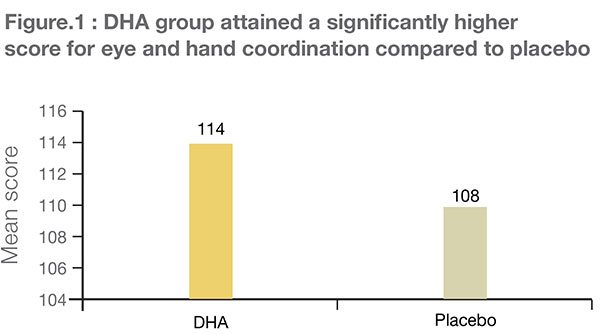A study was conducted to assess the effects of omega 3 fatty acids like DHA on behavior and school attendance rates in school children it also assessed whether omega 3 FA administration decreased clinically apparent sick days from malaria as an independent endpoint.
Hostility-Aggression Questionnaire for Children (HAQ-C) and Barratt Impulsiveness Scale, version 11 (BIS-11), for measurement of aggression and impulsivity, respectively were administered at the start and end of the study.School attendance was recorded during the study period.

he DHA and EPA concentrations in the total phospholipid fraction in red blood cells were significantly increased in the DHA group, whereas there were no significant changes in any fatty acids concentrations in the control group.
The odds ratios of inability to attend school perfectly during the study period in the DHA group were significantly reduced to 0.30 in boys (n=116, p=0.003) and was non-significantly to 0.56 in girls (n=117, p=0.2) compared with the control group. When both sexes were combined, the odd ratio in the DHA group was reduced to 0.42 compared with controls (n=233, p=0.003).
DHA supplementation may improve the school attendance rate of children.
Hamazaki K, Syafruddin D, Tunru IS, et al. The effects of docosahexaenoic acid-rich fish oil on behavior, school attendance rate and malaria infection in school children-a double-blind, randomized, placebo-controlled trial in Lampung, Indonesia. Asia Pac J Clin Nutr. 2008;17(2):258-63.
A randomized, placebo-controlled, double-blind study was conducted to assess the effects of DHA supplementation of healthy preschool children on their cognitive functions like listening comprehension and vocabulary acquisition.
175 healthy 4-year-old children
4 months
400-mg/d DHA (n=85) or matching placebo (n = 90) in capsules
Cognitive tests included the Leiter-R Test of Sustained Attention, Peabody Picture Vocabulary Test, Day-Night Stroop Test, and Conners' Kiddie Continuous Performance Test. The relationship between DHA levels in blood from a subsample (n=93) with cognitive test scores was evaluated.
There was supportive evidence and promising results for a significant relation between higher DHA levels in blood and improved scores on a test of listening comprehension and vocabulary in healthy preschool children.
Ryan AS, Nelson EB. Assessing the effect of docosahexaenoic acid on cognitive functions in healthy, preschool children: A randomized, placebo-controlled, double-blind study. Clin Pediatr (Phila). 2008;47(4):355-62.
Docosahexaenoic Acid (DHA) Oxford Learning and Behavior (DOLAB) trial is a parallel group, fixed-dose, randomized, double-blind, placebo controlled trial (RCT) conducted to assess the effects of algal DHA supplementation on reading, working memory and behavior in healthy school children.


This study provides the first evidence that dietary supplementation with DHA is a safe and effective way to improve learning and behavior in healthy children from the general school population. The supplement was found to be safe and well tolerated.
Richardson AJ, Burton JR, Sewell RP, et al. Docosahexaenoic acid for reading, cognition and behavior in children aged 7-9 years: A randomized, controlled trial (the DOLAB Study). PLoS One.2012;7(9):e43909.
This study was conducted to assess the effects of antenatal omega-3 long-chain polyunsaturated fatty acid (n-3 LC PUFA) on cognitive development in a cohort of children whose mothers received high-dose omega-3 fatty acids in pregnancy.

98 pregnant women (their infants (n=72) were assessed at age 2(1/2) years)
20 weeks’ gestation until delivery.
Omega-3 fatty acids (2.2 gm docosahexae- noic acid (DHA) and 1.1 gm eicosapentaenoic acid (EPA)/day) or olive oil from 20 weeks' gestation until delivery.
Omega-3 fatty acid supplementation in pregnancy shows potentially beneficial effects on child’s eye and hand coordination
Maternal omega-3 FA supplementation during pregnancy is safe for the fetus and infant, and may have potentially beneficial effects on the child's eye and hand coordination.
Dunstan JA, Simmer K, Dixon G, et al. Cognitive assessment of children at age 2(1/2) years after maternal fish oil supplementation in pregnancy: a randomized controlled trial. Arch Dis Child Fetal Neonatal Ed. 2008;93(1):F45-50.
Several studies have demonstrated that supplementation with micronutrients (MNs) or n-3 fatty acids offer health benefits such as reduced illness in school children. This particular study was conducted to determine the effect of a combination of two different doses of micronutrients and n-3 fatty acids on incidence of diseases in school children.

Foods fortified with either high (100% recommended dietary allowance) or low (15% recommended dietary allowance) MN, combined with either high (900 mg r-linolenic acid (ALA) plus 100 mg docosahexaenoic acid) or low (140 mg ALA) n-3 fatty acids for 1 year.
High dose of n-3 fatty acids, including 900mg ALA and 100mg DHA reduces the duration of diseases and the incidence of URTI compared with a low dose of n-3 fatty acids of 140mg ALA in school children.
Thomas T, Eilander A, Muthayya S, et al. The effect of a 1-year multiple micronutrient or n-3 fatty acid fortified food intervention on morbidity in Indian school children. Eur J Clin Nutr. 2012;66(4):452-8.